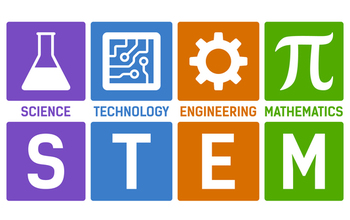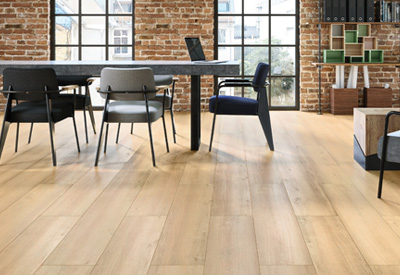Rethinking Classrooms from the Floor Up Posted: Aug 2019 Posted by: Mats Inc.

Best practices & innovative design solutions for STEM makerspaces
Meet the Makerspace
While chalkboards, textbooks, paper and pencils used to be the cornerstones of every classroom, training today’s students for high-tech, globally competitive careers requires a more integrative approach to education design. From early-childhood through pre-college, STEM (Science, Technology, Engineering and Math) curricula are increasingly administered in makerspaces: a hybrid of traditional classroom and laboratory. Think modular layouts that encourage student collaboration and group work; durable surfaces that encourage hands-on exploring, testing and building; and overall adaptability that evolves along with the ever-changing technologies of the world at large.
An innovative spirit is key to the success of tomorrow’s graduates. An interdisciplinary STEM education creates pathways between subjects to foster the critical skills of engagement, free thinking and problem solving.

Between 2010 and 2020, the U.S. Bureau of Labor Statistics projected employment in STEM occupations to grow by 18.7%, as compared to 14.3% for all occupations. Approximately 59% of this increase is reflected in computer/mathematical scientist occupations. The 2017 national average wage for STEM occupations was $87,570 – nearly double the national average wage for non-STEM occupations ($45,700). With this, over 30% of U.S. schools currently have a designated makerspace to focus on STEM, while over 20% more have plans to implement one. Whether starting from the ground up in a new facility like Dearborn STEM 6–12 Early College Academy in the Boston area, or retrofitting existing spaces – makerspaces are designed to turn today’s students into tomorrow’s success stories.
Teach Your Children Well
The sooner students are exposed to STEM coursework, the better prepared they will be to compete in a global economy. At every age, students are encouraged to take a multidisciplinary approach to understanding complex systems, changing the ways in which they learn as they grow. Here’s a look at how makerspace design needs differ, based on grade-level:
ELEMENTARY SCHOOL
A properly provisioned space for younger students to explore, learn and play includes a minimum of two sinks, wall space to display work and open floor space made of durable, easily washable material that can withstand messy projects. Tailor Grace flooring, made of easy-to-clean vinyl, provides a comfortable place to sit and work for little learners – in brilliant water-based colors befitting of children’s all-important first forays into creative learning.
Practitioners of Color Theory suggest brilliant blue hues for use in STEM makerspaces, as the cool shade is said to lower the heart rate and improve concentration.
MIDDLE SCHOOL
The more flexible the space, the better. The ability to easily move, group and rearrange furniture gives a classroom the freedom to become a different place as the lesson plan evolves. Durable, dent-resistant PURline is an ideal base for wheeled workstations and material storage bins, is easy to clean and highly resistant to chemical stains. Made using bio-polyurethane, it’s sustainable as well.
Opt for surfaces that are easy to keep clean. Nonporous flooring that doesn’t require finishing waxing, buffing or stripping is more hygienic, and can withstand common lab spills.
HIGH SCHOOL
Students undertaking more advanced engineering design need dedicated space for ideation, prototyping, fabrication, assembly and testing. With the additions of 3D printers, CNC routers and laser die cutters, fabrication labs – also known as “fab labs” – require similar safety features to any science lab in terms of space and ventilation, but also call for flexibility to add components as technology grows and changes. For students standing for long periods of time, Panorama rubber flooring offers cushiony comfort and bold colorations with slip-resistant, sound-absorbing properties. 3M Safety-Walk matting is ideal for spill-prone areas around sinks.
Collaboration is key to creating the kind of classroom environment that invites idea sharing. Keep the concentration-busting effects of brainstorming to a minimum with the help of sound-absorbing flooring.
STREAM of Consciousness
The theory of Constructivism in education acknowledges the differences in the ways students construct understanding and knowledge of subject matter via their own experiences and reflections therein. In other words, different people learn the same subject matter in inherently different ways.
In conjunction with the rising awareness of the importance of STEM, there’s been a call to create even more inclusionary approaches to education with STREAM (Science, Technology, Reading, Engineering, Arts and Math). Incorporating a broader range of disciplines encourages understanding via various learning techniques that apply to a wider swath of students. For example, a student who may be more artistically inclined can be called upon to use his or her visual design skills to illustrate a complex engineering or computing principle. After all, at the core of a STEM education is the concept of “connected thinking” across subjects. Infusing STEM with creativity captures a greater portion of students – and encourages richer innovation.
Today, educators and designers of educational spaces are being called upon to rethink the traditional classroom from the floor up. Creating the kind of in-school facilities that will support integrated investigation and hands-on makership for its students requires attention to flexibility, safety and creativity. Curricula that revolve around interpersonal collaboration, evolving project-based learning, and various technological implements require an eye toward current trends, and those yet to be imagined. Check out the Makerspace Playbook for more ideas on how to ideate spaces conducive to future learning.
Categories: Education Flooring
| Tweet |






